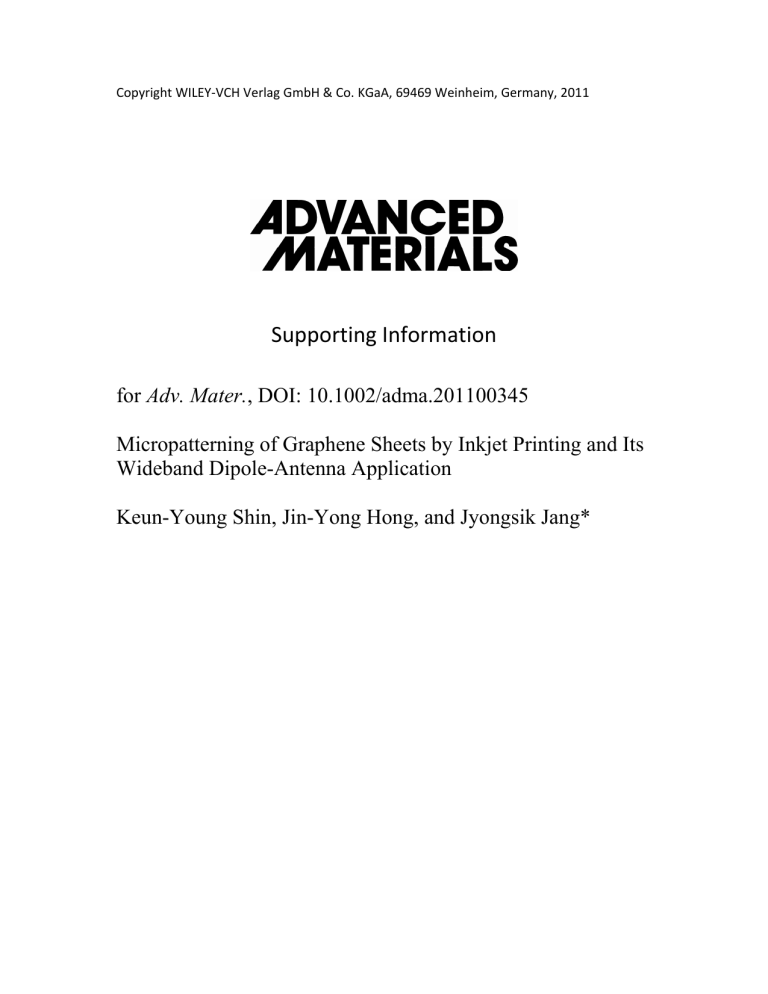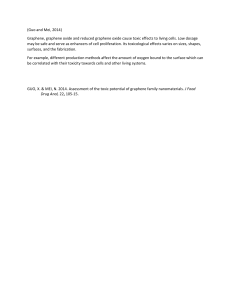
Copyright WILEY‐VCH Verlag GmbH & Co. KGaA, 69469 Weinheim, Germany, 2011 Supporting Information for Adv. Mater., DOI: 10.1002/adma.201100345 Micropatterning of Graphene Sheets by Inkjet Printing and Its Wideband Dipole-Antenna Application Keun-Young Shin, Jin-Yong Hong, and Jyongsik Jang* Submitted to Supporting Information 1. Experimental Section Materials: The graphite flakes used in the majority of experiments was purchased from Sigma-Aldrich (Product Number 332461). GO was printed using a commercial office inkjet printer (Canon Pixima IP1300). Poly (ethyleneterephtalate) (PET, 3M) film was used as a substrate for inkjet printing. Aniline monomer (99 %) and ammonium persulfate (APS, 98 %) were obtained from Sigma Aldrich Co. Ltd, and pyrrole monomer (99 %) was obtained from Acros Organics and used without further purification. Hydrochloric acid (HCl, 35 wt.% in H2O) was purchased from Samjun Chem. Co. and used for doping of PANI. Synthesis of GO dispersion for inkjet printing: Unreduced graphene oxide was synthesized from natural graphite by a modified Hummers and Offeman method as originally presented by Kovtyukhova and colleagues. Synthesized purified GO suspensions were dispersed in water. Exfoliation of GO was achieved by sonication of the dispersion for 3 h to avoid the nozzle blockage. The obtained brown dispersion was then washed for 5 cycles of centrifugation at 3,000 r.p.m. to remove any unexfoliated graphite oxide. Modification of inkjet printer: The ink cartridge (printer head) was disassembled and washed several times by ethanol and distilled water after removing all inks. The exfoliated GO in distilled water was injected into the modified cartridge as an alternative ink. Subsequently, the completely sealed ink cartridge was placed in the printer body and prepared to use for further experiments. Patterning of graphene-based thin film by inkjet printing and hydrazine vapor deposition (VDP): For patterning of graphene sheets onto the PET film, oxygen plasma treatment was 1 Submitted to performed in order to modify the surface energies of target substrate (gas flow rate: 20 sccm, power: 100 W, time: 20 s). The complex patterned architectures were designed by computer software in advance (Microsoft PowerPoint 2003). The exfoliated GO solution was printed on the flexible PET film as the designed images using the modified inkjet printer. Subsequently, the printed film was properly cut and located in VDP chamber containing hydrazine and ammonia solution. The graphene sheets patterns were formed immediately at low temperature (90 °C, 1 h). Patterning of conducting polymers-based thin film by inkjet printing and vapor deposition (VDP): For patterning the conduction polymers such as PPy abd PANI, oxidant agent ammonium persulfate (APS, 0.15 g) in distilled water (5 mL) was injected into the modified cartridge as an alternative ink. In the case of PET film, low temperature oxygen plasma treatment (gas flow rate: 20 sccm, power: 100 W, time: 20 s) was also conducted to increase the hydrophilic property of surface. The oxidant APS solution was printed on the PET film as the designed images. Subsequently, the patterned oxidant was properly cut and located in the VDP chamber containing pyrrole or aniline monomer (1 mL). In case of patterned PANI, dilute hydrochloric acid solution (1 mL of HCl solution in 10 mL distilled water) was also added in the VDP chamber. Immediately, the patterned PPy and emeraldine salt form of PANI were fabricated by thermal treatment (90℃). The fabrication of RFID dipole antenna using the patterned graphene sheets electrode: A 300 nm thick, 300 x 30 mm rectangle GO film on glossy photo paper treated with oxygen plasma was obtained by inkjet printing repeatedly for 30 times. The rectangle GO/PET section was cut using scissors and placed at 90 °C VDP chamber with hydrazine and ammonia solution for 1 h. Patterned graphene sheets of dipole antenna were connected by silver paste to the power supply source. 2 Submitted to Characterization: TEM image was taken with a JEOL 6700F and the XPS spectra were recorded using Kratos Model AXIS-HS system. The AFM topography was obtained by a Digital Instrument Nanoscope IIIA from veeco systems in tapping mode using silicon tips with a resonance frequency of of 320 KHz. Optical micrographs were taken using a Leica DM2500 P and the plasma reactor was of the parallel electrode type with a 13.56 MHz radiofrequency generator. The viscosity was measured by rheometer (AR 2000 Advanced Rheometer, TA Instruments) and the surface energy was calculated by Owens-Wandt equation after measuring the contact angle of distilled water droplet on the film surfaces. The measurement of electrical resistances was performed with a Keithley 2400 sourcemeter at 25 °C by a four-probe method. The sheet resistance was measured at 10 different locations of graphene-based thin film and calculated as an average value. For the RFID antenna characteristics, E5071B ENA RF Network Analyzer of Agilent Technologies was carried out (300 kHz to 8.5 GHz). Impedance was plotted on the smith chart by first normalizing to the characteristic impedance of the system (50 ohms). 3 Submitted to 2. TEM image of the exfoliated GO Figure S1. Representative TEM image of the exfoliated GO as a conducting ink for inkjet printing. For the TEM sample preparation, GO solution was cast onto copper grid. The GO was first prepared from natural graphite by a modified Hummers and Offeman method. Synthesized GO based on aqueous solution can be easily exfoliated as individual GO sheets by sonication, since the functional groups such as hydroxyl, epoxy in the basal plane and carboxyl, carbonyl at the sheet edges make GO sheets hydrophilic and diminish the interaction energy between the graphene layers. The bright-field TEM image displays the exfoliated GO, which is composed of a few micron-sized monolayer, bilayer and multilayer graphene (Fig. S1). In addition, large objects with thickness of more than a few layers were rarely observed by electron microscopy. It demonstrates that the GO can be readily exfoliated to form monolayer and few-layer graphene, dispersing in a stable aqueous solution. 4 Submitted to 3. XPS spectrum of exfoliated GO films by inkjet printing Figure S2. Deconvoluted X-ray photoelectron spectroscopy (XPS) spectrum of patterned GO films by inkjet printing for 1 pass (top image) and 30 passes (bottom image) in the C1s region. Fit lines are labeled as: C−C, C−O, C=O and C−H bonds. Generally, in the XPS study of oxygen plasma activated PET, C1s peak of treated PET is composed of four main components: C1 at a binding energy of 284.0 eV which corresponds to C−H bond (aromatic CH), C2 at 285.0 eV which corresponds to C−C bond (carbon atoms in phenyl ring), C3 at 286.5 eV which corresponds to C−O bond (methylene carbon atoms singly bonded to oxygen), and C4 at 288.9 eV which corresponds to O=C−O bond (ester carbon atoms).[1, 2] The peak composed of three main components (C−C, C−O and C=O bond) also presented patterned GO on PET film treated with oxygen plasma. In order to estimate how intensity of unpatterned PET film affects the XPS analysis, it was also conducted to GO film fabricated on the Si wafer. After that the exfoliated GO solution was drop casting onto the Si wafer treated with oxygen plasma (gas flow rate: 20 sccm, power: 100 W, time: 20 s), spin coating process was performed. In our experiment, the spin-coated GO films were spunon at a speed of 1500 rpm for 50s to obtain the same GO thickness at 1 printing pass on PET substrate. Therefore, the spin-coating process was repeated 30 times. As a result, no 5 Submitted to significant difference in shape or magnitude was seen between the GO films by inkjet printing on the PET film versus spin-coating onto the Si-wafer treated with oxygen plasma. It indicated that the C1s peak intensity by pure PET film was much lower than that by the patterned GO on PET film. Furthermore, the deconvoluted C1s XPS spectrums of patterned GO by inkjet printing for 1 pass and 30 passes are presented in Figure S2. In the case of 1 pass, C1 peak (C−H bond) originated from the PET film was additionally inserted. As the printing number increased, the C1 peak intensity of the aromatic CH component was reduced. As a result, we can’t see the peak any more in the C1s XPS analysis of patterned GO film obtained by repeat printing for 30 passes. 6 Submitted to 4. The comparison with line resolution Figure S3. The optical micrographs of patterned straight lines of a) graphene sheets b) PPy c) PANI with the width of ca. 70 µm. In all images, the scale bar is 50 µm. For the comparsion with line resolution, we fabricated the patterned polypyrrole (PPy) and polyaniline (PANI) as representative conducting polymers onto PET film via the same inkjet printing and VDP method. In general, conducting polymers are insoluble into common solvents because the delocalized electrons of conducting polymer hinder solubilization in polar solvents. One way to prepare soluble conducting polymers is to use a stabilizer which has negatively charged functional groups in water. Such stabilizer makes a conducting polymer soluble in water due to the electrostatic interaction between conducting polymer and stabilizer. However, these additives cause electrical conductivity to drop and inkjet printer to destruct mechanically. For this reason, we fabricated patterned conducting polymers via chemical oxidative polymerization of vaporized monomer on inkjet-printed oxidant patterns in the VDP chamber without additives such as stabilizer and surfactant. Our group already presented this method in the previous research about the fabrication of uniform conduction polymer pattern.[3, 4] To pattern the conducting polymers, oxidant agent ammonium persulfate (APS) in distilled water was injected into the modified cartridge as an alternative ink, and the monomer vapor could deposited on the surface via VDP process. In case of patterned PANI, 7 Submitted to dilute hydrochloric acid solution was also added in the VDP chamber to make the emeraldine salt form. Figure S4. FE-SEM image of the surface morphology of patterned graphene sheets at a) low and b) high magnification, PPy at c) low and d) high magnification and PANI at e) low and f) high magnification on PET substrate. The graphene sheets, PPy, PANI patterns with minimum ca. 70 µm line width due to limitation of used inkjet printer are visualized in Figure S3. It demonstrates that well-defined patterns of patterned graphene sheets are more clearly observed on the PET film than that of the other conducting polymers. This difference of resolution was related to rapid polymerization process, matching surface energy between substrate and ink, and grain 8 Submitted to property on domain structure. Generally, the evaporated monomers were deposited and polymerized on the patterned oxidant APS film without physical hesitation or stirring. It might lead to the fast growth of polymer film with cracks and wrinkles. In other words, when the monomers were polymerized, solidification of polymers occurred during the polymerization. Consequently, attraction forces between polymer nanoparticles caused aggregations on random parts of surface, which appeared in the wrinkled form. Furthermore, high difference of surface tension between APS ink and oxygen-treated PET film caused matching problem of surface energy, resulting in forming line-edge waveness, In addition, Figure S4 shows stacks of planar structure of patterned graphene sheets on the large domain. For these reasons, high resolution of patterned graphene could be obtained. 9 Submitted to 5. Gradient pattern of graphene sheets with different surface resistance Figure S5. The photo image of gradient patterned graphene sheets with controlled surface resistance as a function of lightness. Grayscale images were designed by computer software in advance (Microsoft PowerPoint 2003). We performed experiments to demonstrate the gradient pattern clearly. First, various grayscale patterns were designed by computer software in advance (Microsoft PowerPoint 2003). Then, the grayscale patterned GO film was printed out by repeat printing for 10 passes, and the reduction process was conducted via VDP method. Figure S5 shows that the gradient patterns of graphene sheets were successfully fabricated, and the surface resistance can be controlled according to the grayscale lightness. Moreover, it implied that the electrical conductivity could be readily regulated in the same line, and suggested possibility to fabricate various types of electrodes. 10 Submitted to 6. Dipole antenna application Table S1. VSWR and Return Loss of designed dipole antenna by patterned graphene sheets. VSWR Retun Loss Reflection Coefficeint (Γ) Transmitted Power Reflected Power 1.44 14.9 0.144 96.7 3.3 [a] These values were acquired in the E5071B ENA RF Network Analyzer of Agilent Technologies. In general, the wavelength of substrate-based antennas is inverse proportional to frequency, and the length of designed antenna is selected according to antenna types and wavelength. λ is defined as with c = 2.998 x 108 m/s and f = 500 MHz, ½ λ would be equal to 30 cm. Two key parameters such as bandwidth and voltage standing wave ratio (VSWR) or return loss (RL) of the antenna have to be considered to evaluate the performance of the designed antenna.[5, 6] The bandwidth is basically frequency that the antenna is required to radiate, and the VSWR represents that the measure of how efficiently frequency power is transmitted from a power source and is defined as The voltage reflection coefficient, Γ, is defined as where ZL is the load impedance presented in smith chart and ZO is the characteristic impedance (50 Ω). The RL, the magnitude of the reflection coefficient in dB, is defined as A large positive return loss indicates that the reflected power is small relative to the incident power and implies good impedance match from source to load. 11 Submitted to 7. References [1] A. Vesel, M. Mozetic, A. Zalar, Vacuum 2008, 82, 248. [2] H. Kumagai, D. Hiroki, N. Fujii, T. Kobayashi, J. Vac. Sci. Technol. 2004, 22, 1. [3] J. Cho, K. Shin, J. Jang, Thin Solid Films 2010, 518, 5066. [4] J. Cho, K.-H. Shin, J. Jang, Synthetic Metals 2010, 160, 1119. [5] X. Qing, N. Yang, IEEE Antennas and Propagation Society International Symposium 2004, 1, 97. [6] Y. Tikhov, J. H. Won, Electronics Letters 2004, 40, 574. 12



